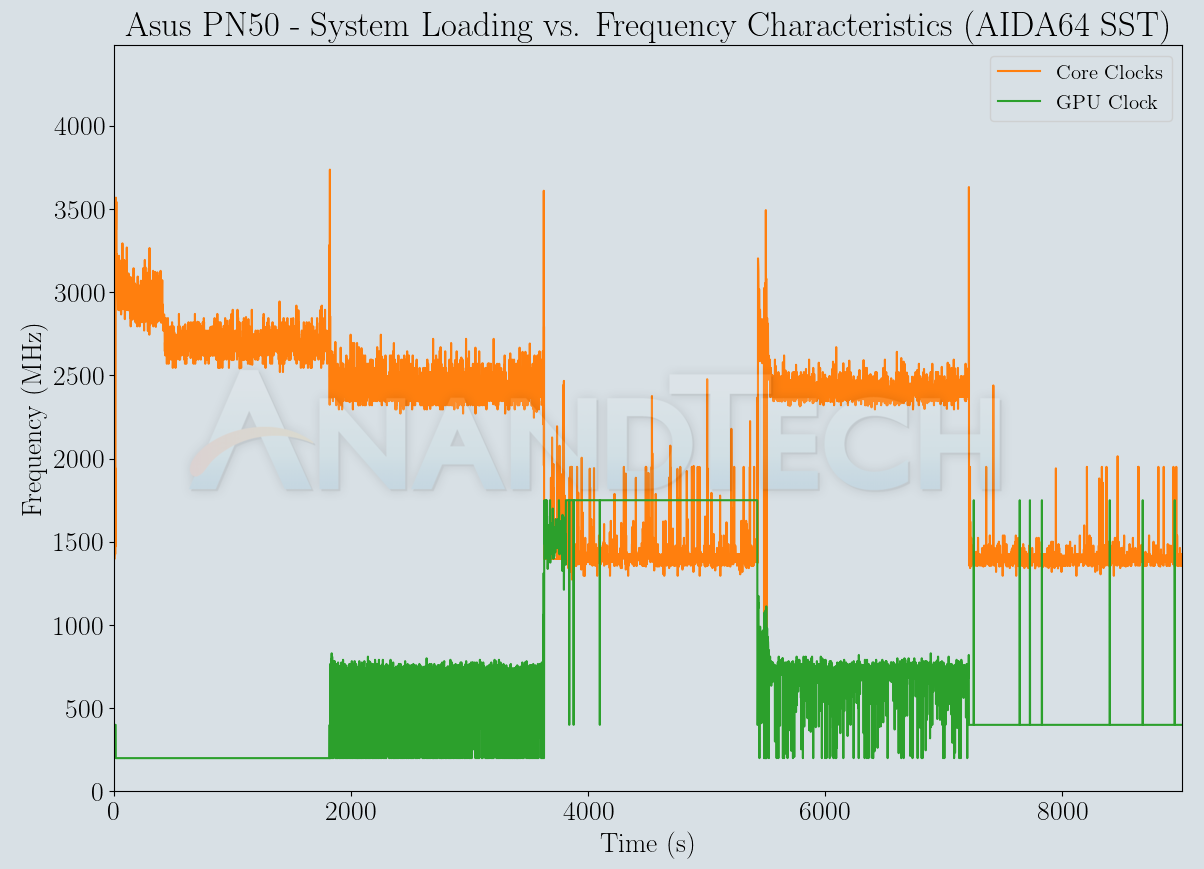ASUS PN50 mini-PC Review: A Zen 2 Business NUC
by Ganesh T S on October 1, 2021 10:00 AM EST- Posted in
- Systems
- AMD
- Asus
- NUC
- UCFF
- Mini-PC
- Zen 2
- Ryzen Embedded
- Renoir
- Ryzen 4000
- Ryzen 7 4800U
Power Consumption and Thermal Performance
The power consumption at the wall was measured with a 4K display being driven through the HDMI port. In the graph below, we compare the idle and load power of the ASUS PN50 with other low power PCs evaluated before. For load power consumption, we ran the AIDA64 System Stability Test with various stress components, as well as our custom stress test with Prime95 / Furmark, and noted the maximum sustained power consumption at the wall.

Thanks to the use of a low-power SSD and lesser amount of RAM compared to systems such as the 4X4 BOX-4800U and the NUC BOX-1165G7, the PN50 makes an appearance in the middle of the chart for idle power. The system is placed second in terms of peak load power consumption, coming behind the Tiger Lake system.
Our thermal stress routine starts with the system at idle, followed by four stages of different system loading profiles using the AIDA64 System Stability Test (each of 30 minutes duration). In the first stage, we stress the CPU, caches and RAM. In the second stage, we add the GPU to the above list. In the third stage, we stress the GPU standalone. In the final stage, we stress all the system components (including the disks). Beyond this, we leave the unit idle in order to determine how quickly the various temperatures in the system can come back to normal idling range. The various clocks, temperatures and power consumption numbers for the system during the above routine are presented in the graphs below.
| ASUS PN50 System Loading with the AIDA64 System Stability Test | |||

The average frequency of the cores stays well above the rated 1.8 GHz whenever the CPU is loaded. GPU clocks range from 200 MHz at idle to around 1.7 GHz at full load. On the temperatures side, we see throttling kick in when the cores reach around 95C. The iGPU itself doesn't cross 85C even under load. Under stress, the SSD does reach around 75C - pointing to the need for a thermal pad or some other thermal solution for the storage device. The at-wall power consumption stays between 40 - 45W (with package power contributing 25W) prior to throttling. After the temperature reaches 95C, the package power drops down to 20W, and the at-wall number comes down to around 35W. In contrast, the ASRock Industrial 4X4 BOX-4800U using the same SoC sustains a package power of 15W under load. This explains the reason for the ASUS PN50 outscoring the 4X4 BOX-4800U across many benchmarks.
p>
The custom stress test involves running Prime95 for 30 minutes, followed by the addition of the Furmark stress workload. After 30 minutes, the Prime95 load is removed, and the Furmark workload is allowed to run for 30 minutes. The system is then left idle for 30 minutes.
| ASUS PN50 System Loading with Prime95 and Furmark | |||

The core and GPU frequencies behave similar to he AIDA64 SST, though Furmark limits GPU frequency to around 1.5 GHz. Throttling kicks in after the core temperature hits 95C, and we see the 25W to 20W package power transition play out in this case also.
Overall, the thermal solution in the Asus PN50 is perfect for a 20W TDP configuration. Asus seems to allow 25W TDP operation until the thermal solution is overwhelmed. Once the core temperature hits the 95C threshold, the operating TDP is scaled down to something more manageable for the form factor and thermal design of the system.










32 Comments
View All Comments
meacupla - Friday, October 1, 2021 - link
I feel like, if Asus skipped the 2.5" SATA drive, they could have used a beefier heatsink to allow 25W operation with no thermal throttling.Integr8d - Friday, October 1, 2021 - link
I agree. The little fan would spin up that much less frequently. It's not bad though (and if I ran mine behind the monitor, I'm sure I'd never hear it).StevoLincolnite - Friday, October 1, 2021 - link
Not to mention a last gen Ryzen...Samus - Friday, October 1, 2021 - link
Agreed. They should at least consider a separate SKU that axes the 2.5" drive and slightly increases the heatsink surface area, as you said. This would cost almost nothing as a case rework wouldn't be necessary: all they need to change is the heatsink and perhaps the blower.YB1064 - Saturday, October 2, 2021 - link
Anemic 1GbE and a previous gen Ryzen...no thanks.dotjaz - Sunday, October 3, 2021 - link
PN50E1 has the 2.5GbE. As for lastgl gen APU, what's your point? 5000 series won't be much faster because it's still thermal limited.Samus - Monday, October 4, 2021 - link
Seriously like the Ryzen 4xxx-U's are slow or something...they're insanely fast.TheinsanegamerN - Thursday, October 7, 2021 - link
Just because they are fast doesnt mean people want to pay current gen pricing for a last gen product.powerarmour - Saturday, October 2, 2021 - link
It feels out of date already too, I'm not sure why anyone would want to buy this now.Oxford Guy - Saturday, October 2, 2021 - link
If companies don’t include egregious flaws how is there an incentive to upgrade sooner rather than later? Fix one flaw, get a new one.